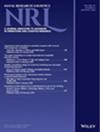A branch‐and‐price‐and‐cut algorithm for the truck‐drone routing problem with simultaneously delivery and pickup
IF 2.1
4区 管理学
Q3 OPERATIONS RESEARCH & MANAGEMENT SCIENCE
引用次数: 0
Abstract
Abstract Increasing environmental concerns and e‐commerce has attracted a growing focus on reverse logistics that not only delivers some goods to customers but also picks up other goods from customers. To achieve cost‐efficient and fast deliveries, integrating drones into the delivery and pickup services provides a competitive advantage, which however increases the operational challenges. We consider a truck‐drone routing problem with simultaneous delivery and pickup, where each truck carries a set of heterogeneous drones. Each truck can simultaneously perform its own delivery and pickup, and serve as an intermediate movable depot from which multiple drones can be dispatched to serve customers when the truck arrives at a customer, and the truck must wait until all the drones return. The energy consumption of drones is considered during their flights. All the delivery services must be performed, whereas the pickup services are optional with certain rewards. The objective is to find the synthetic‐routes of the truck‐drone combinations so as to minimize the sum of the assignment cost and the transport cost of the trucks and drones minus the total pickup revenue. To solve the problem, we devise a tailored branch‐and‐price‐and‐cut algorithm incorporating a specialized two‐stage bidirectional labeling algorithm to solve the challenging pricing problem. To enhance the efficiency of the algorithm, we use the subset‐row inequalities to tighten the lower bound, and apply some heuristic pricing strategies to quickly solve the pricing problem. We perform extensive numerical studies to assess the performance of the developed algorithm, analyze the merit of the truck‐drone cooperative service mode over the truck‐only service mode and the superiority of the configuration with heterogeneous drones, and ascertain the impacts of the key model parameters to generate managerial insights. We also show how our model would perform should it be used for the medical supply delivery and pickup in Shenzhen, China.同时配送和取货的卡车无人机路线问题的分支-价格-切割算法
日益增长的环境问题和电子商务吸引了越来越多的关注的逆向物流,不仅提供一些商品给客户,但也从客户拿起其他商品。为了实现成本效益和快速交付,将无人机集成到交付和取件服务中提供了竞争优势,但这增加了运营挑战。我们考虑了一个同时送货和取货的卡车-无人机路线问题,其中每辆卡车携带一组异构无人机。每辆卡车可以同时执行自己的送货和取货,并作为一个中间移动仓库,当卡车到达客户时,可以从那里派遣多架无人机为客户服务,卡车必须等待所有无人机返回。无人机在飞行过程中考虑了能耗。所有的送货服务都必须执行,而取件服务是可选的,并有一定的奖励。目标是找到卡车-无人机组合的综合路线,以最小化分配成本和卡车和无人机的运输成本减去总拾取收入的总和。为了解决这个问题,我们设计了一个定制的分支-价格-切割算法,该算法结合了一个专门的两阶段双向标记算法来解决具有挑战性的定价问题。为了提高算法的效率,我们使用子集行不等式来收紧下界,并采用一些启发式定价策略来快速解决定价问题。我们进行了广泛的数值研究,以评估所开发算法的性能,分析卡车-无人机合作服务模式相对于卡车-无人机服务模式的优点,以及异构无人机配置的优越性,并确定关键模型参数的影响,以产生管理见解。我们还展示了如果将我们的模型用于中国深圳的医疗用品交付和提取,它将如何执行。
本文章由计算机程序翻译,如有差异,请以英文原文为准。
求助全文
约1分钟内获得全文
求助全文
来源期刊

Naval Research Logistics
管理科学-运筹学与管理科学
CiteScore
4.20
自引率
4.30%
发文量
47
审稿时长
8 months
期刊介绍:
Submissions that are most appropriate for NRL are papers addressing modeling and analysis of problems motivated by real-world applications; major methodological advances in operations research and applied statistics; and expository or survey pieces of lasting value. Areas represented include (but are not limited to) probability, statistics, simulation, optimization, game theory, quality, scheduling, reliability, maintenance, supply chain, decision analysis, and combat models. Special issues devoted to a single topic are published occasionally, and proposals for special issues are welcomed by the Editorial Board.
 求助内容:
求助内容: 应助结果提醒方式:
应助结果提醒方式:


